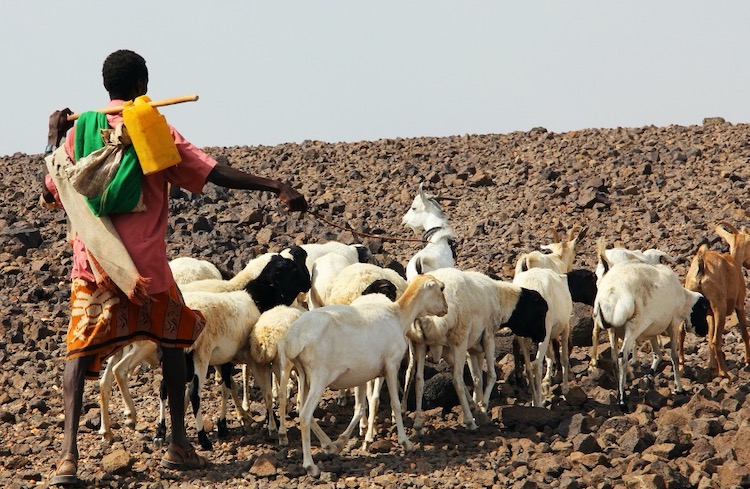
by hms59 | Nov 23, 2021 | Dashboard, Visualization

One morning in February, in Kaffrine Region, Senegal, Kaffia Diallo emerged from her tent. She is happy; her new grandson was born just two days earlier. “A beautiful baby,” she said, “although I wish he weighed a little more.”
Following tradition, they will wait seven days before giving him a name. Surrounded by their herds of cows, sheep and goats, Kaffia helped her daughter with the birth in their tent in the middle of the brush, far from the closest medical center. This is nothing new for Kaffia. She comes from a family of livestock herders who seasonally move their herds from one place to another, along with some 800,000 herders in Senegal and millions of others throughout the Sahel.
“We have always been a family of herders and I began moving our herds when I was 15 years old,” Kaffia explained. “But now that I am old, I stay in the village and take care of my grandchildren.
´One billion children at ‘extremely high risk’ of the impacts of the climate crisis – UNICEF.
´Young people living in the Central African Republic, Chad, Nigeria, Guinea, and Guinea-Bissau are the most at risk of the impacts of climate change, threatening their health, education, and protection, and exposing them to deadly diseases, according to a UNICEF report.
Global average temperatures have increased by more than 1℃ since pre-industrial times. Human emissions of carbon dioxide and other greenhouse gases – are a primary driver of climate change – and present one of the world’s most pressing challenges. … Overall, this would amount to an average temperature rise of 1.1℃
- CO2emissions have increased by about 90%, with emissions from fossil fuel combustion and industrial processes contributing about 78% of the gas emissions increase from 1960 to 2020.
- Over the entire industrial era, some 2.3 trillion tons of carbondioxide have been released to the atmosphere. …
- One of the most promising initiatives and projects are the Carbon Capture Capacity projects.
- Globally, there are 15 large-scale CCS projects in operation, with a further seven under construction.
- The total CO2 capture capacity of these 22 projects is around 40 million tonnes per annum (Mtpa).

by khh16 | May 13, 2021 | Dashboard
“I want people, when they realize they have been wrong about the world, to feel not embarrassment, but that childlike sense of wonder, inspiration, and curiosity that I remember from the circus, and that I still get every time I discover I have been wrong: “Wow, how is that even possible?”
― Hans Rosling, Factfulness: Ten Reasons We’re Wrong About the World—and Why Things Are Better Than You Think
Air pollution has always been an environmental health threat and a problem that countries suffer from until today. Our analysis starts with an interactive Gapminder followed by a brief discussion about Air pollution between two countries Sweden and South Africa .
Each caption will guide you to our main objective that is: Air pollution affects Life expectancies of countries like South Africa where they are subject to a less clean Air (nearly 1 million deaths in Africa are caused by Air pollution).As Hans Rosling stated: Yes we should be embarrassed .Solving this crucial problem remains a big challenge for all the countries. Therefore, a collective work from citizens and government is much needed to build cleaner, greener and sustainable cities.

by khh09 | May 10, 2021 | Uncategorized

Meet Ahmad
Ahmad is a young and healthy adult who likes to engage in various sports. However, he suffers from severe cases of asthma and regularly takes prescribed medications along with his inhaler. Like many people his age, Ahmad is very ambitious about his future and hopes one day that he can become a world star athlete.
Unfortunately, Ahmad is living in Qatar which is known to have a very harsh environment that is filled with air pollution and CO2 emissions that can risk his healthcare and well being.
Let’s Examine what Ahmad is up against!
The following Visual is a Bar Chart displaying the average CO2 emissions (metric tons per capita) in Arab countries
Observations

Ahmad was simply shocked!!
Although Ahmad knew that Qatar had very high levels of air pollution, he was not excepting it to be the highest among all other Arab countries. Ahmad had to act fast and think about ways to convince his parents to finance his journey to a cleaner country with low levels of greenhouse gas emissions. However, the previous graph was not entirely convincing for his father since he wanted to have a more visual understanding of the countries.
A better Visual?
The following Visual is the same visual presented before but projected on the map of the Arab World
Before Deciding
 Although it seemed Obvious for Ahmad to travel to any of the countries that had low levels of C02 emissions, Ahmad’s Father wanted his son to have a good future prospect. The father demanded to know which of these countries had low levels of unemployment. After a lot of hard work, Ahmad was able to come up with a great visual that explains exactly what his father wants.
Although it seemed Obvious for Ahmad to travel to any of the countries that had low levels of C02 emissions, Ahmad’s Father wanted his son to have a good future prospect. The father demanded to know which of these countries had low levels of unemployment. After a lot of hard work, Ahmad was able to come up with a great visual that explains exactly what his father wants.
Now That’s Clearer
The following Visual is a Stacked Bar chart displaying the average CO2 emissions (metric tons per capita) and % of unemployment in Arab countries
Problem Solution
| Potential Solutions |
Solution Validation |
Recommendation |
| For Better Future: Convince Ahmad’s father to finance his travel to Saudi Arabia |
it has less CO2 levels (12.62) with slightly higher unemployment rate (5.58%) |
Try Exploring other Non-Arab Countries that meet Ahmad’s requirement |
| For Better Health: Convince Ahmad’s father to finance his travel to Lebanon |
it has significantly less CO2 levels (2.96) but a higher unemployment rate (8.63%) |
If to stay in Qatar for guaranteed employment, Ahmad should drastically change his lifestyle and become more health cautious |
Conclusion
 Ahmad has choices There is no “perfect” solution for Ahmad’s Situation but he has a few options to explore. The problem in our Arab World is that we are (in most cases) required to sacrifice important aspects of our lives to improve other aspects. This dilemma is affecting so many people across the Arab World, especially during these hard times.
Ahmad has choices There is no “perfect” solution for Ahmad’s Situation but he has a few options to explore. The problem in our Arab World is that we are (in most cases) required to sacrifice important aspects of our lives to improve other aspects. This dilemma is affecting so many people across the Arab World, especially during these hard times.

by Emily El Hajj | May 7, 2021 | Visualization
How often do we hear about our planet’s environmental crises but how rarely do we witness any sort of actions implemented to tackle this issue!
Who are the largest contributors to CO2 emissions hence deteriorating our environment?
What do these contributors share in common?
As Greta Thunberg stated ‘ Our so-called “role models” indeed have some work to do. It’s pretty hard to SOLVE the climate crisis without addressing these elephants in the room.
Let’s explore the largest contributors and what they share in common.








